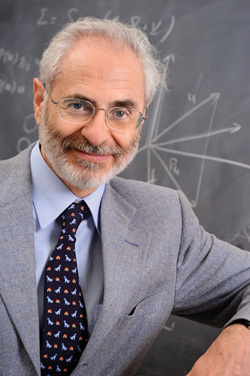For the Department of Mechanical Engineering and Andrea Prosperetti, February 9, 2012, was a day to break out the bubbly.
That was the day that Prosperetti, the Charles A. Miller Jr. Distinguished Professor of Mechanical Engineering, was elected to the National Academy of Engineering, one of the highest professional honors an engineer can receive, for his “contributions to the fundamentals and applications of multiphase flows.”
In fluid mechanics-the study of the motion of fluids such as air and water-a multiphase flow is one in which some combination of gases, liquids, and solids flows together: such as when water flow transports sand at the bottom of the ocean, when wind or waves shape sand into a dune, or when someone pops a bottle of champagne, spewing forth a mixture of liquid and gas.
Johns Hopkins celebrates a long history in fluid mechanics. In the 1940s and 1950s, Francis Clauser, Stanley Corrsin and Leslie Kovasznay made significant contributions to the understanding of turbulence. Owen Phillips’ seminal work in the 1950s and 1960s described the shapes of giant ocean waves, knowledge that has guided the design of ships. In 1979, when Johns Hopkins engineering reemerged as the Whiting School, William Sharpe started recruiting scholars to establish a reinvigorated department of mechanical engineering. Prosperetti, a native of Italy and a graduate of the California Institute of Technology,was an early hire. Other esteemed fluid mechanics researchers soon followed, solidifying the university’s eminence in the field. In 1996, Johns Hopkins’ Center for Environmental and Applied Fluid Mechanics was established.
At the university, Prosperetti has focused much of his research on bubbles, tiny pockets of gas within a liquid. Many industrial gas-liquid chemical reactions require bubbling the gas at the bottom of a container containing the liquid. In electric power generation, the turbines are driven by vapor obtained by boiling the liquid and forming vapor bubbles. Ultrasonic dental instruments blast the tartar off your teeth with tiny bubbles.
Many of us enjoy lying on the beach and listening to the ocean foaming and waves breaking, but for Prosperetti, bubbles are serious business. “Prosperetti is the first person who understood that bubbles made that sound and explained it, modeled it, computed it, and quantified it,” says Joseph Katz, the William F. Ward Sr. Distinguished Professor of mechanical engineering, and one of the researchers Prosperetti helped hire. “He has a great gift as an applied mathematician, and he is the leading authority in the field of bubble dynamics.”
He’s also a guy who’s more interested in the long-term effects of research than the immediate benefits. “You can study something, and someone says, ‘But what’s it good for?-that’s just how it works.’ But nobody who studied electricity in the 1800s knew it would become an industry,” Prosperetti says. “Sometimes we find solutions in search of a problem.”

Those problems haven’t been so hard to find. With support from the Office of Naval Research, Prosperetti found that rain-induced underwater noise in the ocean, which may interfere with a submarine’s ability to detect a torpedo, is caused by bubble clouds, and he suggested changing the frequency of these sonar devices. This finding also gives scientists a new way-sensors measuring bubble noise-to measure rainfall across oceans, an important component of climate science.
Recently, Prosperetti has been studying bubble-generated microjets in air. Because of their high velocity, these microjets are able to penetrate the skin and could thus replace the needles used to deliver vaccines and other medicines, eliminating such problems as needle contamination and needle phobia. He has been conducting this research with colleagues from the University of Twente in the Netherlands, where Prosperetti holds a part-time appointment and travels about 10 times a year.
“Some fields of research offer great depths still waiting to be explored, and fluid mechanics is one of them, due to its complexity and widespread applications,” he says. “This is what fascinates me.”




